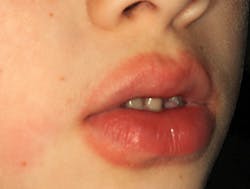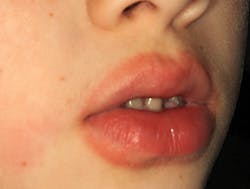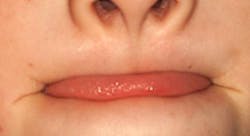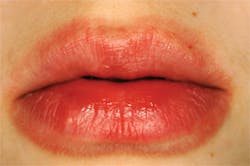Oral exam: Damage caused by lip sucking
Daniel is nine years old and is accompanied by his mother for his dental appointment with you. As you greet both Daniel and his mother, you notice that the child has some irritation around the mouth and his lips appear very swollen. As you talk with his mother, she is extremely concerned by this appearance and tells you that it never seems to improve. She tells you that she tries to keep Vaseline on the area and notices that the child has problems eating spicy foods because he says, “It burns.” The mother believes that he may have some type of food allergy.
Figure 1: Swollen lip tissue in young boy. Note irritated oral facial tissue around vermillion border and note malocclusion. Courtesy of Dr. Elena Barbería, Complutense University, Madrid, Spain.
Daniel is seeing you today for a prophylaxis and general dental exam. As you talk to Daniel, you notice that he exhibits a problem with his occlusion and a noticeable overjet. You believe that this could be contributing to his problem with his lip irritation. You observe that he also appears to be placing his upper lip over his lower lip and sucking on the lip tissue.
All of these issues can contribute to this clinical appearance of swollen lips, redness, and chapping. In this particular case, Daniel is sucking on his lips, and this is affecting his occlusion. After talking with him, he realizes that he is performing this habit and wants to change this behavior (see Figure 1).
Oral habits that occur both in children and adults affect swallowing, with an abnormal position of the lips. Depending upon the length of time the behavior is practiced, tissue trauma, nerve, and facial ramifications may be noticed. Prolonged thumb sucking, lip licking, lip biting, cheek chewing, mouth breathing affect both the oral and perioral tissues, An intolerance to certain foods or dental products may produce a similar clinical appearance with erythema and swelling of the lips. In most cases, these habits may go unrecognized by dental practitioners or parents, and this delays treatment for the patient even more. Psychological dependency on the actual ongoing habit is problematic and worsens with time (see Figures 2, 3).
Constant trauma to the delicate lip tissues is detrimental, resulting in dryness and abrasion. Stripping of the thin outer layer of tissue on the lips causes peeling of the tissues even extending out past the vermilion border of the lips. The constant bathing of the lip tissues in saliva is very irritating as well, promoting the redness and chapping of the perioral tissues. Most often, practitioners diagnose this entity of lip sucking in the winter months because of the lack of moisture during the colder months, resulting in increased chapping and dryness of the lip tissue (see Figure 4).
Oral habits and related problems occur in adults as well as children. But it may be more difficult to dissipate in children since they do not have an established way of coping with certain behaviors.
Adults can assist in their attempt to break habits such as cheek chewing, lip biting, thumb sucking, or lip sucking. Children may actually continue a habit to gain parental attention once a focus has been established on the actual behavior. Children need to understand the consequences of the habit, and those younger than eight years old may be unable to fully assist in trying to eliminate the habit.
Barbería et al. (2006) suggest that the child must want to work with the clinician and have an understanding of the lip sucking in order for resolution of the behavior. Barbería points out that continuing to raise the lower lip over the upper lip causes a puckering in the chin or the symphysis because of the continued use of these muscles. The researchers also state that a strong contraction of the lower lip’s orbicularis muscle promotes overuse of these structures. Barbería states that the mentalis muscle associated with hypertonicity in the upper lip due to the sucking action must be counteracted by tongue thrust during deglutition, possibly causing an overjet.
Lower lip sucking occurs in children when mental attention and concentration are required in situations such as a new environment, a stressful environment, or a new task being learned that causes stress for the child. Once the habit is formed, it may be continued even when the child is removed from the stimulus. Breaking this habit may even mean introducing psychological interventions and assistance from a mental health professional.
Lip sucking in childhood is not rare, but probably underdiagnosed. The very subtle clinical presentations or the ramifications may go unnoticed by clinicians unless the parent calls the clinical signs to the attention of the clinician or the results are severe enough to gain attention. Some children may be more susceptible to lip sucking because of certain personality traits making them more vulnerable once the behavior is initiated.
In addition, some children have a problem with occlusion, such as an overjet. Because of this overjet, placing the lower lip tissue in the space between the mandible and maxillae becomes much easier to accomplish. Over time, the placement of the lip tissue in between the maxillae and the mandible might actually contribute to the problem with occlusion, making it much worse or maybe even creating it initially.
The dentist and the dental hygienist are in an excellent position to assess the occlusion of the child and determine what may be contributing to the irritated areas of the lips. Being aware of the possible etiology of lip sucking assists the practitioner in a good differential diagnosis based on a thorough health history and an excellent clinical evaluation.
As always, keep asking good questions and always listen to your patients. RDH
Author’s note: My thanks to Dr. Elena Barbería for her assistance in collaborating, sharing her research, and volunteering her expertise with this column. Dr. Barbería is a professor of pediatric dentistry at Complutense University in Madrid, Spain.
References:
1. Barbería E, Lucavechi T, Cardenas D, Maroto M. An atypical lingual lesions resulting from the unhealthy habit of sucking the lower lip: clinical case study. J Clin Pediatr Dent 30(4):280-282, 2006.
2. Burkhart NW. Morsicatio buccarum, labiorum and linguarum. RDH. 12:2011.
Guidelines for Assisting Clinicians in Diagnosing and Extinguishing Behaviors Associated with Lip Sucking
• Careful evaluation of all patients with regard to occlusion, speech, swallowing patterns, and any deviations from normal should be addressed. Current or future oral habits may be identified and corrected.
• If the child is older, explain the esthetic importance that discontinuance of the behavior will have for him/her. Adolescents and older children are especially concerned with their appearance, and this approach may be all that is needed. The child must want to make the behavior change and be of an age that he/she understands the concept. Additionally, trust with the clinician must be established.
• Explain to the child (and parents) the cause of the injuries and inform them of the importance of discontinuing any habit when this is appropriate for the situation.
• Determine when the habit is more practiced and teach self-management techniques that work for the individual. For example, does it occur at night, during the day, or during stressful daily activity.
• In the young child (under 8 years old), it is very difficult for him/her to understand the importance of eliminating the habit. Parental involvement is very important, but the clinician must know the family. If parental involvement is sought, will it be beneficial or might it actually make the situation worse for the child (such as punishment of the child)?
• In some cases, the habit is an unconscious mechanism of the child to get additional attention from parents. If parents call attention to the habit, the child increases frequency and this reinforces the habit. The problem could become worse, and parents need to understand this concept if they are involved.
• If the problem is minor, a “watch and see” approach may be best, since calling attention to the issue may actually reinforce the behavior. Careful documentation and follow-up is needed.
• In some cases, psychological support may be needed depending upon the individual circumstances and the severity of the problem.
• At any age, apply creams or treatment for skin lesions to keep the tissue from getting infected and abraded.
• Extraoral images are encouraged since progress over time may be documented, evaluated, and actually decrease the anxiety of the parent who is concerned about progress.
Past RDH Issues
About the Author
Nancy W. Burkhart, EdD, MEd, BSDH, AAFAAOM
NANCY W. BURKHART, EdD, MEd, BSDH, AAFAAOM, is an adjunct professor in the Department of Periodontics-Stomatology, College of Dentistry, Texas A&M University, Dallas, Texas. She is founder and cohost of the International Oral Lichen Planus Support Group (dentistry.tamhsc.edu/olp/) and coauthor of General and Oral Pathology for the Dental Hygienist, now in its third edition. Dr. Burkhart is an academic affiliate fellow with the American Academy of Oral Medicine, where she also serves as chair of the Affiliate Fellowship Program Committee. She was awarded the Dental Professional of the Year in 2017 through the International Pemphigus and Pemphigoid Foundation, and she is a 2017 Sunstar/RDH Award of Distinction recipient. Her professional interests are in the areas of oral medicine and the relationship between oral and whole-body health, with a focus on mucosal disease and early oral cancer detection. Contact her at [email protected].





